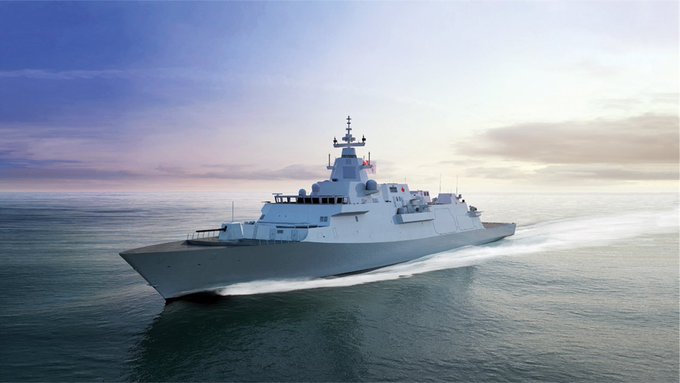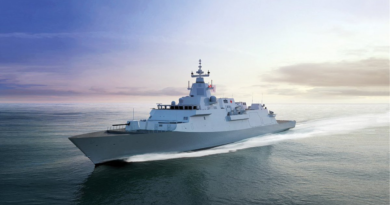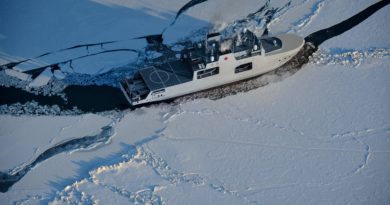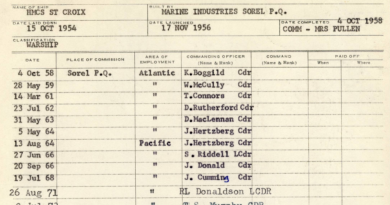Types of Royal Canadian Navy Combatant Warships
Destroyers, frigates and corvettes are surface combatant1 warships, generally employed at escort and patrol. The three types of ships feature in the history and current fleet structure of the Royal Canadian Navy. The following provides some information about the differences between the three. Each type description starts with its two letter type designation and official definition.2
Destroyers, frigates and corvettes range in size and capabilities down from destroyers to corvettes, all less than cruisers and greater than subchasers and other small warships. Though size is a distinguishing feature in official definitions, what is important in typing a vessel is its intended role(s), often evident in the ship’s sensors and weapons fit. Other features, such as sea keeping, endurance, ‘depth of magazine’ (number of missiles), power (for sensors and weapons) and growth margin (space, etc., reserved for new sensors and weapons fitted later in a ship’s life) are less or not at all evident.
DD – destroyer, general – General designator for destroyer type ships. Major surface combatant in range of about 95 to 140 metres whose general mission is to conduct operations with strike, ASW (anti-submarine warfare) and amphibious forces, and to perform screening and convoy duties. May have helicopters not especially fitted for ASW. 2
Destroyers originated in the late 1800s as torpedo-boat destroyers, not much bigger than the torpedo boats against which they were to defend the battle fleet. Destroyers took on the torpedo boat role, increasing their torpedo and gun armament and growing in size. Originally they tended to work in groups (flotillas) and were serviced by destroyer tenders (large base ships), distinguishing characteristics out of which they have grown as they became larger, and as weapons and sensors became smaller and easier to fit onboard. Modern destroyers are as large as or larger than older cruisers, now displacing anywhere from 5,000 to 15,000 tonnes, and have taken on many of the cruisers’ roles (trade protection, scouting, screening of high value ships). Modern destroyers have greater size and power than frigates and corvettes which enable them to carry large air defence radars and surface-to-air missile magazines. They are also often capable of many of other roles: anti-surface, anti-submarine, anti-ballistic missile and land attack. Destroyers still tend to be thought of in their traditional function as escorts for naval groups of aircraft carriers and amphibious ships. Destroyers have figured prominently in Canadian thinking as our ‘major combatants.’
FF – frigate, general – General designator for frigate. A surface combatant in size range of about 75-150 metres. Fitted primarily to fulfil an ASW role. Generally has lighter surface armament than DD. 2
Modern frigates were developments from corvettes during the Second World War to address seakeeping, speed and other issues with corvettes. Modern frigates are larger than those war versions, displacing 2,500 to 7,500 tonnes, and have much greater deployability – Canadian frigates have been employed on missions throughout the world. Frigates at first were usually anti-submarine vessels but now are capable of other roles though not to the extent of destroyers. Anti-submarine frigates are built with quietening features which other ships may not have. Frigates still tend to be thought of their traditional function as escorts for convoys of naval supply ships and civil merchant ships. Modern frigates, like destroyers, are a sign of ‘blue-water’ (ocean-going) aspirations of a country and navy,
FS – corvette – Small escort in size range 60 to 100 metres. 2
Corvettes were developed as a contingency measure at the start of the Second World War to allow more shipyards to build anti-submarine escorts, as current escorts such as sloops were too difficult. Changes were made during the war to improve issues with the corvettes, becoming ‘twin-screw corvettes’ and then a new type, the frigate. Canada disposed of its corvettes after the war; they had not been built to last. Other nations continued building the ships, which can now displace 1,000 to 2,500 tonnes. Though improvements in sensors and weapons have allowed an increased combat capability beyond anti-submarine, including launching of land attack missiles, corvettes lack endurance and seakeeping. Corvettes are employed more as regional and local vessels, and countries that operate them as a major part of their fleet are indicating regional, not blue-water, aspirations.
The type names frigate, sloop and corvette originated during the sailing ship era, describing vessels of certain layouts and sailing rigs. There was a recent opportunity for the Royal Canadian Navy to use another name from the sailing era – the newly built Harry DeWolf-class, typed by the Navy as Arctic and Offshore Patrol Vessel (less armed but in this case bigger than corvettes and some frigates and destroyers), could have been typed after a small warship that sailed in British North America in the 18th century: the snow.3
Notes:
- Combatant: Naval, Coast Guard and Government-owned vessels/craft which possess some sort of inherent armed or combat capability primarily intended for offensive use. (APP-20 article 0101.1.a.)
- NATO APP-20 Standard Ship Designator System Edition A Version 3 May 2016
- Snow – The largest of all old two-masted vessels. The sails and rigging on the main mast of a snow are exactly similar to those on the same masts in a full-rigged ship; only that there is a small mast behind the mainmast of the former, which carries a sail nearly resembling the mizzen of a ship. When used as a military vessel, snows were, in the early 18th century, typically fitted with 5 to 16 guns. Military snows were mostly used for coastal patrols and privateering, while in the merchant service, snows traded all the way to the Mediterranean and sometimes even sailed as far as the West Indies. (http://en.wikipedia.org/wiki/Snow_(ship))




